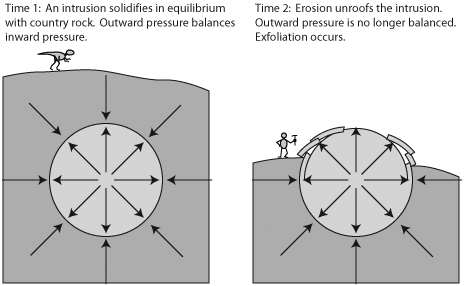To log this cache email me the following, please keep the answers and logs within a reasonable around of time of each other.
- Looking at the sides of the fins west of you, do the exfoliated plates seem the same size?
- Are they congregated all the way up, or just in certain layers?
- Are there more on the East or West? What are the differences (if any)
- Looking only to the West, do the exfoliation plates seem to be the same thickness or different?
- Post a photo of you here without giving away the answers, a foot, Geocaching coin, or your GPS.
- Add a photo of you from the location or of an identifiable item (paper with trackable name). Posting a photo pulled from the internet, or photoshopped will result in instant deletion.
Other caches in the area go into the formation of the fins because of the salt dome. This cache is about he erosion that takes place of those fins themselves and why it takes place the way that it does.
Typical Erosion
Normally, the erosion of stone takes place grain by grain. Sometimes the weaker grains will erode faster and cause a larger chunk of rock to come loose and fall free. (Think of balanced rock, another Earthcache in the park). The wind and rain will remove the softer material. However, there is a pressure inside rocks because of how they were formed. This creates a different kind of erosion.
Under Pressure
Over time, pressures build up in rocks. Many layers of stone on top of it cause the stone to compress, squishing the stone more and more. Think of it as a cushion on a couch. You have enough of a cushion and padding that when you sit on it, it compresses it tighter and tighter. Eventually, If you have enough weight on top of it, the cushion will be completely flat. Layers of sediment, water, and gravity all work to compress the material. It is stone, and the compression may be very small because stone does not compress a lot, however it is under pressure.

Relieving of the Pressure
Then eventually you will climb up out of the couch. When you climb off of the cushion, it will expand. The pressure is gone, and it needs to go somewhere. The same happens in stone. As pressure is relieved, the stone starts to move, slightly. Under most conditions, the stone does not actually change much. However, depending on temperature ranges, hardness of the stone, weathering, etc. the stones can start to flake.
Normally, flaking takes place "with the grain" or with the deposits. There is usually a weaker and a stronger layer, and they will break in between them. However, other times these can break along another surface. The flaking that takes place is referred to as exfoliation. In other words, the breaking off of pieces larger than a grain by grain weathering.
Vertical exfoliation on a horizontal deposit... blah blah blah
Yes I know. That is a lot of big fancy words that is very confusing. My caching buddies head is now spinning (sorry Cold1). In other words, the deposits here are even with the ground. They have been deposited and laid down by an ocean floor, and are not very tipped. The swelling of the salt dome below caused these fins to split under the bubble moving upward (or the sides moving down). This caused the surrounding fins to form.
Then the relieving of pressure takes place. You can an example in the picture above. The water seeping into the sides of the sandstone, the heating and cooling, and the pressure that is pushing outward, causes plates to form on the surface. They crack and form joint under the surface. Tap it with something (a stone or something sightly heavy) If the sound is solid, there is not a joint there, however you can find a number of hollow sounding thumps because it is cracked and in the process of falling off.
Other important notes
Permission given by the National Park Service
Report any Vandalism to Park Rangers
Remember, it is hot in the summer and plan for it. Summer temps can hit 100° F (40°). That will not be the temperature on the rocks. It will be higher. Be prepared with a hat, sunscreen, and lots and lots of water.
Credits
Picture from the University of Maryland geology website.